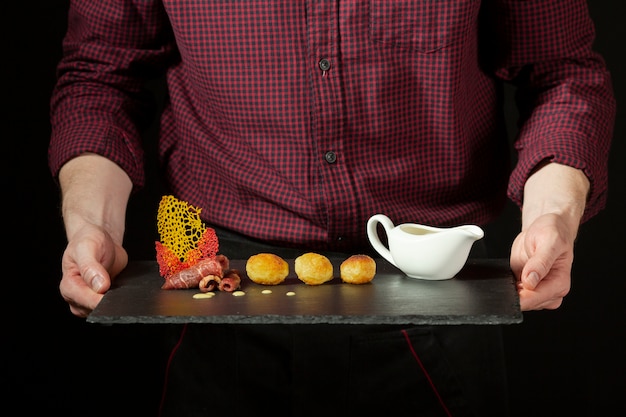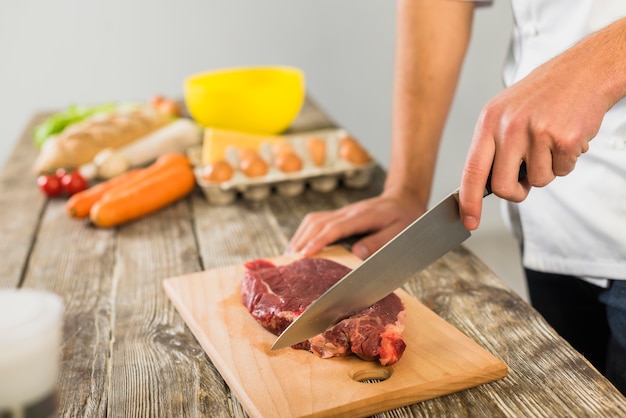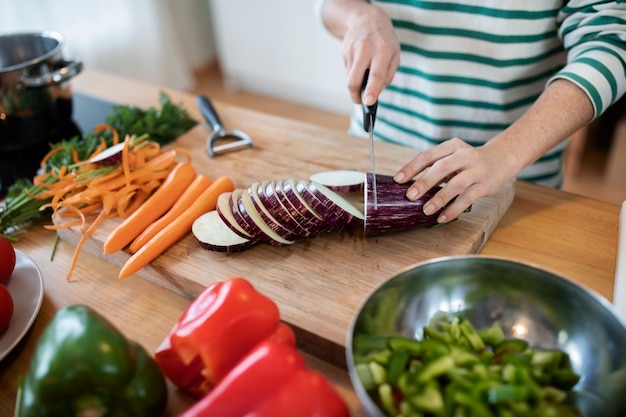(Part 1) Choosing the perfect tri tip

Understanding the Cut:
First things first, let's talk about what tri tip actually is. It's a triangular-shaped cut of beef from the bottom sirloin, located near the tail. It's a lean cut, but it's also known for its rich flavour and tender texture when cooked correctly.
What to look for:
Firstly, let's talk about the meat itself. I always advise going for a good quality tri tip from a reputable butcher. Look for a cut that has good marbling, which indicates a richer flavour and a more tender texture. The fat streaks throughout the meat will melt during cooking, adding moisture and flavour. You want a piece with a nice even shape, free from any blemishes or excessive fat.
When I'm selecting tri tip, I also pay attention to the colour. A bright red colour is usually a sign of freshness. Avoid anything that looks dull or has a grayish hue, as this could indicate the meat isn't as fresh.
Tri Tip Sizes:
I generally prefer a tri tip that weighs around 2-3 pounds. This is a good size for a family dinner or for entertaining guests. It’s enough meat to make sure everyone gets a generous serving, but it’s not so big that it’s overwhelming. You can also cook smaller tri tips for a smaller group or a quick meal, but they will cook more quickly. A smaller tri tip might be perfect for a weeknight dinner for two, while a larger one is ideal for a weekend barbecue with friends.
(Part 2) Preparing the Tri Tip

Trimming the Fat:
Now, let's get our hands dirty! Tri tip usually has a good layer of fat on one side, and this is what we're going to work with. It’s important to trim away any excess fat, leaving about a ??-inch layer for flavour and moisture. You can do this with a sharp knife, but a good pair of kitchen shears make this job much quicker and easier. Remember, trim carefully to avoid removing too much fat, as this will contribute to the flavour and keep the meat moist during cooking. If you trim too much, the meat might dry out, leading to a less succulent final product.
Seasoning the Tri Tip:
This is where your personal touch comes in! I love a good rub on my tri tip, and here's my go-to recipe:
- 1 tbsp kosher salt
- 1 tbsp black pepper
- 1 tbsp smoked paprika
- 1 tsp garlic powder
- 1 tsp onion powder
- ?? tsp dried oregano
- ?? tsp dried thyme
Combine all ingredients in a small bowl, then rub it all over the tri tip. Make sure to get the seasoning into every crevice and nook. This is also a great opportunity to get creative with your flavour profiles. Experiment with different herbs, spices, and even citrus zest! You can even try adding a touch of brown sugar for a sweet and smoky flavour. Remember, a little bit of experimentation goes a long way!
If you want to take your tri tip to the next level, you can also try marinating it before cooking. A simple marinade of soy sauce, olive oil, and garlic will add extra flavour and moisture to the meat. You can even add a dash of honey or lemon juice for a little zing!
(Part 3) Cooking Methods

Grilling
Grilling is my absolute favourite way to cook tri tip. It brings out the smoky flavour beautifully and results in a perfect sear. I use a charcoal grill and let the coals get good and hot. You want the coals to be white-hot, as this will provide the intense heat needed for a good sear. Then, I place the tri tip over the hottest part of the grill and sear each side for about 3 minutes.
You’re aiming for a nice crispy sear, so don’t be afraid to get those grill marks going. After searing, move the tri tip to a less direct heat and continue cooking until it reaches your desired level of doneness. You can do this by moving the tri tip to a cooler part of the grill or by closing the grill lid to reduce the heat.
Pan-Searing
Don't worry if you don't have a grill, you can still achieve a fantastic result with pan-searing. You'll need a heavy-bottomed pan, preferably cast iron. Cast iron retains heat well, which is essential for getting a good sear. Heat the pan over medium-high heat, then add a bit of oil. Choose an oil with a high smoke point, such as avocado oil or grapeseed oil, to prevent burning. Once the pan is hot, carefully place the tri tip in the pan and sear each side for about 3 minutes.
You'll want to make sure that you don't overcrowd the pan, as this will lower the temperature and prevent a good sear. If your pan is too small for the tri tip, you can sear it in batches, ensuring that you don't overcrowd the pan each time.
oven roasting
If you're looking for a less hands-on approach, oven roasting is a great option. Preheat your oven to 400 degrees Fahrenheit (200 degrees Celsius). Place the tri tip in a roasting pan and roast for 15-20 minutes, or until the internal temperature reaches 130 degrees Fahrenheit (54 degrees Celsius) for medium-rare.
To ensure a juicy and tender result, I always recommend using a meat thermometer. This allows you to accurately gauge the internal temperature of the meat, eliminating the guesswork. A good meat thermometer is an invaluable tool for any home cook. If you don’t have one, it's a worthwhile investment.
(Part 4) Internal Temperature and Doneness
Temperature Chart:
Using a meat thermometer is crucial to achieve the perfect level of doneness for your tri tip. Here's a handy chart showing the recommended internal temperatures for different levels of doneness:
| Doneness | Internal Temperature (°F) | Internal Temperature (°C) |
|---|---|---|
| Rare | 125-130 | 52-54 |
| Medium-Rare | 130-135 | 54-57 |
| Medium | 135-140 | 57-60 |
| Medium-Well | 140-145 | 60-63 |
| Well Done | 145 | 63 |
Remember, these are just guidelines. You can adjust the internal temperature to your personal preference. For example, if you prefer your tri tip a bit more well-done, you can cook it to 140 degrees Fahrenheit (60 degrees Celsius).
(Part 5) Resting Time
Once your tri tip has reached the desired internal temperature, it's crucial to let it rest for 10-15 minutes before slicing. This allows the juices to redistribute throughout the meat, resulting in a more tender and flavourful cut. I find it helpful to cover the tri tip loosely with foil, letting it rest in a warm place.
The resting time is also a good opportunity to prepare your favourite sides. I like to pair my tri tip with roasted vegetables, creamy mashed potatoes, or a simple salad. You can even try making a quick pan sauce from the drippings in your pan to add a touch of extra flavour to your meal.
(Part 6) Slicing the Tri Tip
After resting, it's time to slice and enjoy! This is where a sharp knife comes in handy. I like to slice the tri tip against the grain, which means slicing perpendicular to the muscle fibres. This helps to break down the tough fibres and create a tender and juicy cut.
You can slice the tri tip into thin, even slices or thicker pieces, depending on your preference. For a more impressive presentation, I sometimes slice the tri tip into thin, fan-shaped pieces. A sharp chef's knife or a serrated bread knife are both great options for slicing tri tip.
(Part 7) Serving and Enjoying
The final step! Plate your beautifully sliced tri tip with your chosen sides, and get ready to enjoy your culinary masterpiece. I like to drizzle a little bit of pan sauce over the meat, which adds a touch of flavour and richness.
Remember, the beauty of tri tip lies in its versatility. It can be enjoyed in a variety of ways, from simple grilled steaks to more elaborate dishes. I love using leftover tri tip for sandwiches, salads, or even tacos. The possibilities are endless!
(Part 8) Tips and Tricks
Marinate It:
If you want to add extra flavour to your tri tip, you can marinate it for several hours or even overnight. I like to use a simple marinade of soy sauce, olive oil, and garlic. You can also add other ingredients, such as ginger, honey, or lemon juice, to create your own unique flavour profile.
Smoke It:
For a truly unique flavour experience, you can smoke your tri tip. I like to smoke my tri tip over hickory wood for a rich, smoky flavour. If you're using a smoker, try experimenting with different wood chips to find the flavour that suits your taste.
Add a Glaze:
For an extra touch of sweetness and flavour, you can glaze your tri tip with a sauce or BBQ glaze during the last 10 minutes of cooking. I love a simple glaze of honey and soy sauce. You can also try using a fruity glaze, such as a blackberry or apricot glaze, for a more complex flavour.
Don't Overcook It:
One of the biggest mistakes people make when cooking tri tip is overcooking it. Overcooked tri tip can become tough and dry. Always use a meat thermometer to ensure that you cook your tri tip to the desired level of doneness. And remember, it’s better to err on the side of undercooking than overcooking.
Keep It Simple:
Sometimes the simplest recipes are the best. If you're new to cooking tri tip, don't be afraid to start with a simple recipe. Just salt and pepper will do wonders for this flavorful cut of meat. You can always add more complex seasonings and glazes as you become more confident in the kitchen.
(Part 9) FAQs
1. How do I know if the tri tip is done?
The best way to determine if the tri tip is done is to use a meat thermometer. Insert the thermometer into the thickest part of the meat and make sure it reaches the desired internal temperature.
2. What if I overcook the tri tip?
Overcooked tri tip can become tough and dry. If you find that your tri tip is overcooked, try slicing it thinly and using it in other dishes, like tacos or salads. You can also try shredding it and using it in a sandwich or burrito.
3. Can I freeze tri tip?
Yes, you can freeze tri tip for up to 3 months. Make sure to wrap it tightly in plastic wrap and then in aluminum foil. Freezing tri tip is a great way to have it on hand for a quick meal later.
4. What are some good sides to serve with tri tip?
Tri tip pairs well with many sides, including roasted vegetables, mashed potatoes, creamy polenta, salad, and baked beans. You can also try serving it with a side of rice, couscous, or pasta.
5. What's the best way to reheat leftover tri tip?
You can reheat leftover tri tip in the oven, microwave, or on the stovetop. I prefer to reheat it in the oven at a low temperature, around 300 degrees Fahrenheit (150 degrees Celsius), for about 15 minutes. This will help to keep the meat moist and prevent it from drying out.
I hope this guide has inspired you to tackle the deliciousness of tri tip. It's a cut of meat that's worth exploring, and once you've mastered it, you'll be adding it to your regular rotation of favourite recipes! Happy cooking!
Everyone is watching

How to Cook Frozen Lobster Tails Perfectly: A Step-by-Step Guide
RecipesLobster. Just the word conjures up images of lavish meals, special occasions, and a taste of luxury. But let's...

Pigs in a Blanket Cooking Time: How Long to Bake for Perfect Results
RecipesAh, pigs in a blanket. Just the name conjures up images of those delightful little parcels of crispy pastry en...

Pork Fillet Cooking Time: How Long to Cook It Perfectly
RecipesPork fillet, or tenderloin as it's sometimes called, is a real favourite in our house. It's so versatile, and...

The Ultimate Guide to Cooking Delicious Frankfurters
RecipesLet's face it, we all love a good frankfurter. It's a classic, simple, and always satisfying. But let's be rea...

Wolf Meat Recipes: A Guide to Cooking Wild Game
RecipesLet's be honest, you don't see wolf meat at your local butcher shop every day. It's a bit of a wild card, but ...
